Organizational Behaviour Report: Culture, Teams, and Motivation at LG
VerifiedAdded on 2023/01/03
|14
|3786
|52
Report
AI Summary
This report provides an analysis of organizational behavior within LG, a technology company. It explores the influence of culture, power, and politics on employee behavior, emphasizing the importance of a positive organizational culture. The report examines motivation techniques, including Maslow's hierarchy of needs and goal-setting theory, to achieve organizational goals. Furthermore, it compares effective and ineffective teams, highlighting key characteristics such as communication, decision-making, and conflict resolution. The report concludes by applying these organizational behavior philosophies and concepts to the context of LG, offering insights into improving team performance and overall organizational success. The report utilizes Handy's Culture Model, Chantel's factors, and French & Raven's theory to explain the concepts in detail.
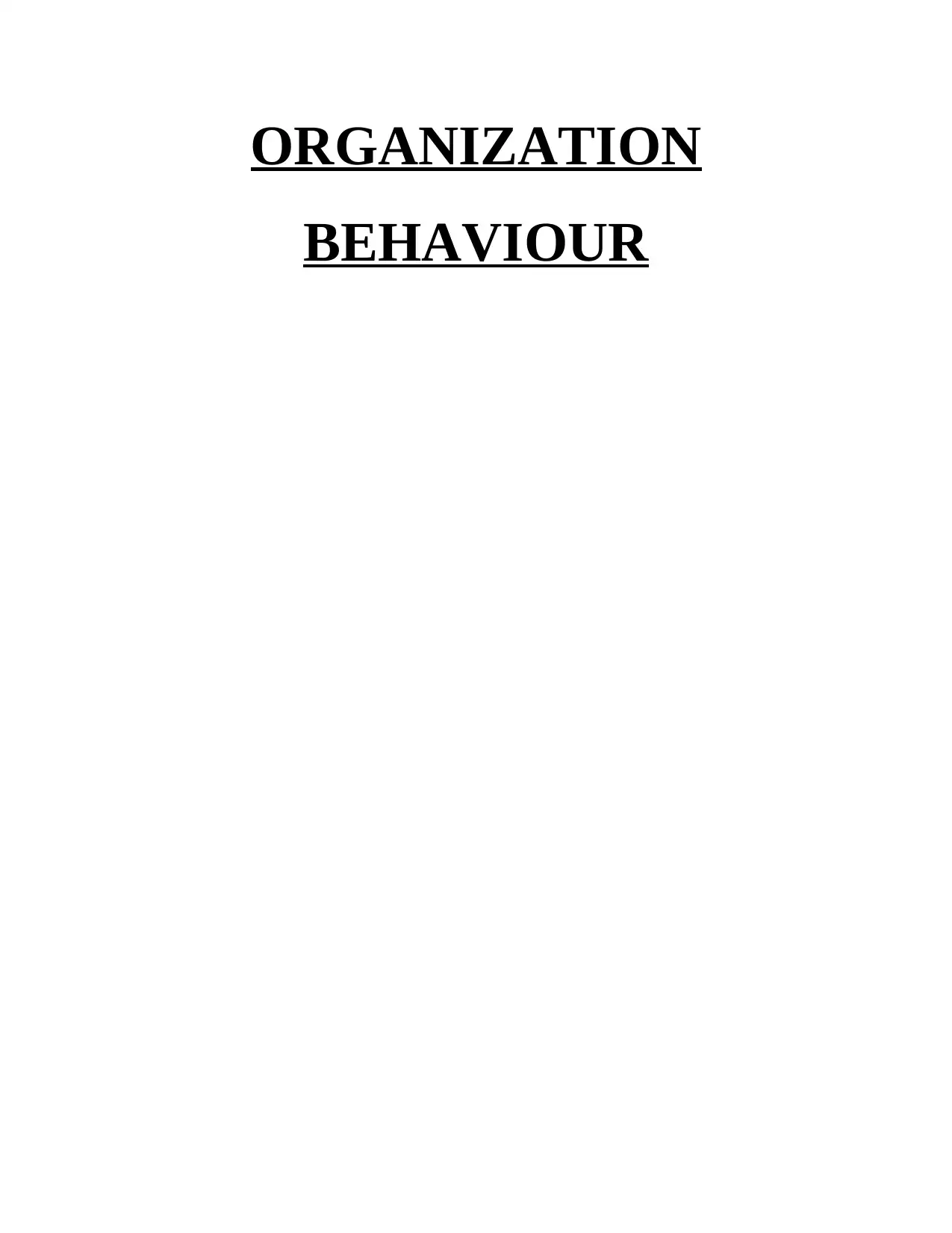
ORGANIZATION
BEHAVIOUR
BEHAVIOUR
Paraphrase This Document
Need a fresh take? Get an instant paraphrase of this document with our AI Paraphraser
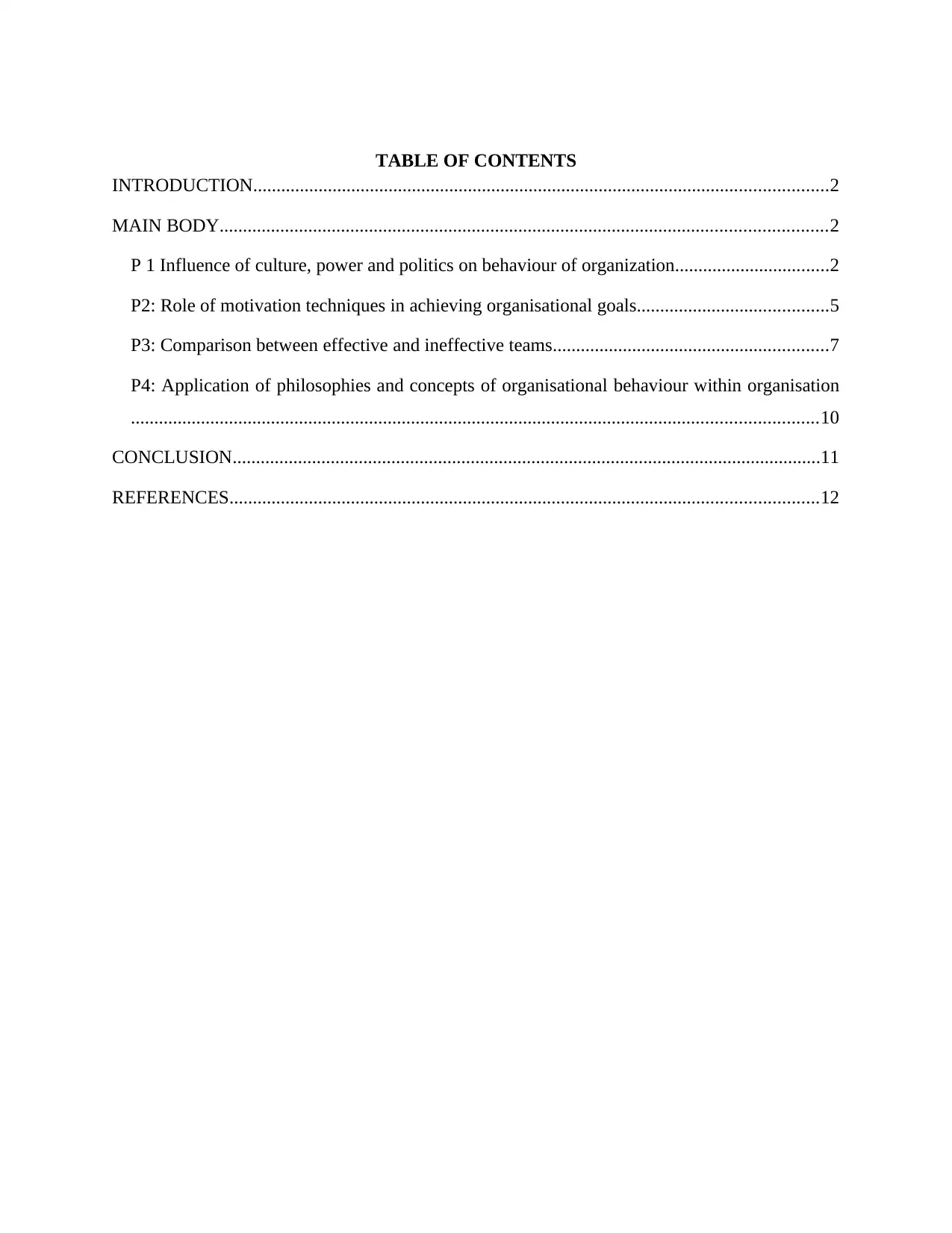
TABLE OF CONTENTS
INTRODUCTION...........................................................................................................................2
MAIN BODY..................................................................................................................................2
P 1 Influence of culture, power and politics on behaviour of organization.................................2
P2: Role of motivation techniques in achieving organisational goals.........................................5
P3: Comparison between effective and ineffective teams...........................................................7
P4: Application of philosophies and concepts of organisational behaviour within organisation
...................................................................................................................................................10
CONCLUSION..............................................................................................................................11
REFERENCES..............................................................................................................................12
INTRODUCTION...........................................................................................................................2
MAIN BODY..................................................................................................................................2
P 1 Influence of culture, power and politics on behaviour of organization.................................2
P2: Role of motivation techniques in achieving organisational goals.........................................5
P3: Comparison between effective and ineffective teams...........................................................7
P4: Application of philosophies and concepts of organisational behaviour within organisation
...................................................................................................................................................10
CONCLUSION..............................................................................................................................11
REFERENCES..............................................................................................................................12
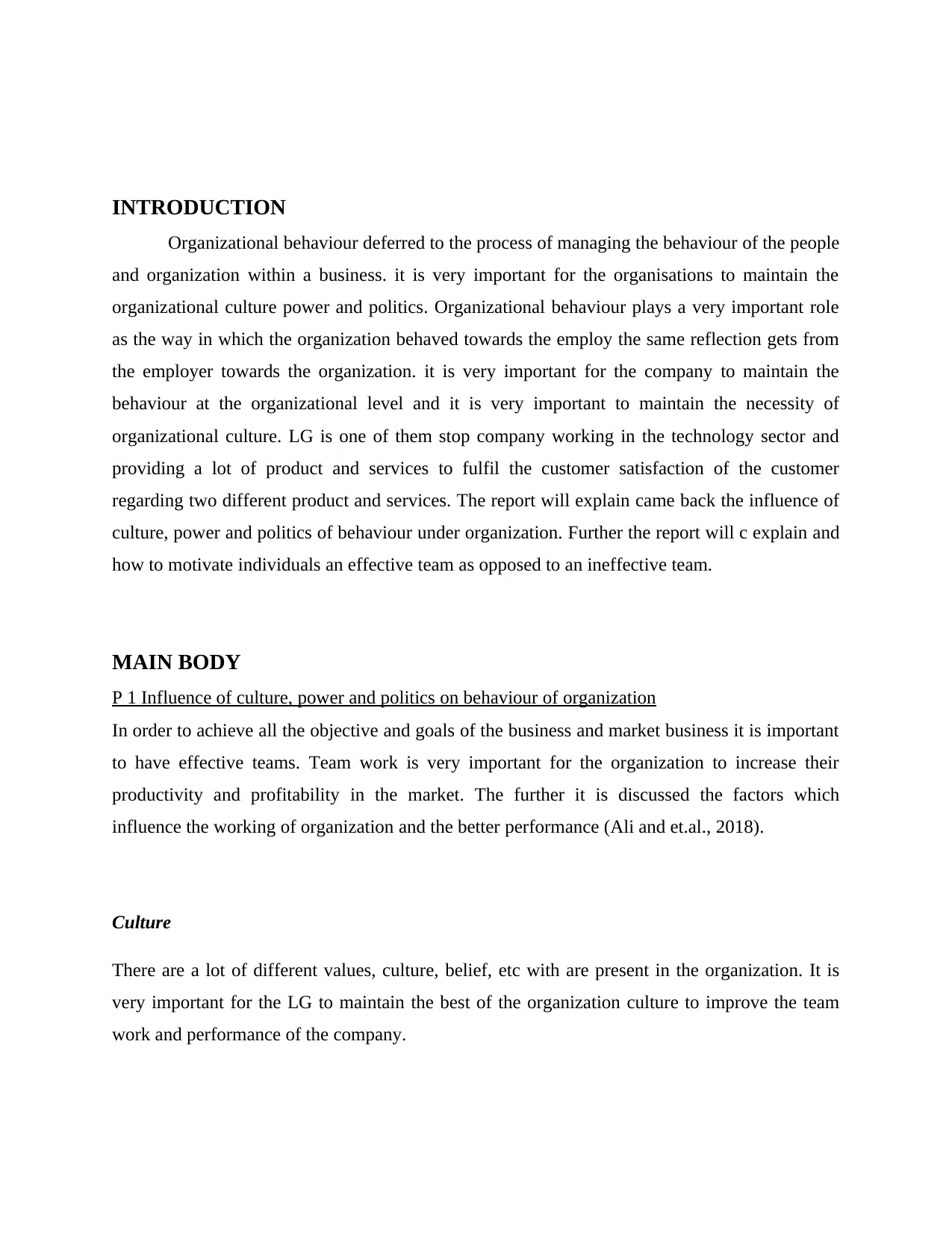
INTRODUCTION
Organizational behaviour deferred to the process of managing the behaviour of the people
and organization within a business. it is very important for the organisations to maintain the
organizational culture power and politics. Organizational behaviour plays a very important role
as the way in which the organization behaved towards the employ the same reflection gets from
the employer towards the organization. it is very important for the company to maintain the
behaviour at the organizational level and it is very important to maintain the necessity of
organizational culture. LG is one of them stop company working in the technology sector and
providing a lot of product and services to fulfil the customer satisfaction of the customer
regarding two different product and services. The report will explain came back the influence of
culture, power and politics of behaviour under organization. Further the report will c explain and
how to motivate individuals an effective team as opposed to an ineffective team.
MAIN BODY
P 1 Influence of culture, power and politics on behaviour of organization
In order to achieve all the objective and goals of the business and market business it is important
to have effective teams. Team work is very important for the organization to increase their
productivity and profitability in the market. The further it is discussed the factors which
influence the working of organization and the better performance (Ali and et.al., 2018).
Culture
There are a lot of different values, culture, belief, etc with are present in the organization. It is
very important for the LG to maintain the best of the organization culture to improve the team
work and performance of the company.
Organizational behaviour deferred to the process of managing the behaviour of the people
and organization within a business. it is very important for the organisations to maintain the
organizational culture power and politics. Organizational behaviour plays a very important role
as the way in which the organization behaved towards the employ the same reflection gets from
the employer towards the organization. it is very important for the company to maintain the
behaviour at the organizational level and it is very important to maintain the necessity of
organizational culture. LG is one of them stop company working in the technology sector and
providing a lot of product and services to fulfil the customer satisfaction of the customer
regarding two different product and services. The report will explain came back the influence of
culture, power and politics of behaviour under organization. Further the report will c explain and
how to motivate individuals an effective team as opposed to an ineffective team.
MAIN BODY
P 1 Influence of culture, power and politics on behaviour of organization
In order to achieve all the objective and goals of the business and market business it is important
to have effective teams. Team work is very important for the organization to increase their
productivity and profitability in the market. The further it is discussed the factors which
influence the working of organization and the better performance (Ali and et.al., 2018).
Culture
There are a lot of different values, culture, belief, etc with are present in the organization. It is
very important for the LG to maintain the best of the organization culture to improve the team
work and performance of the company.
⊘ This is a preview!⊘
Do you want full access?
Subscribe today to unlock all pages.

Trusted by 1+ million students worldwide
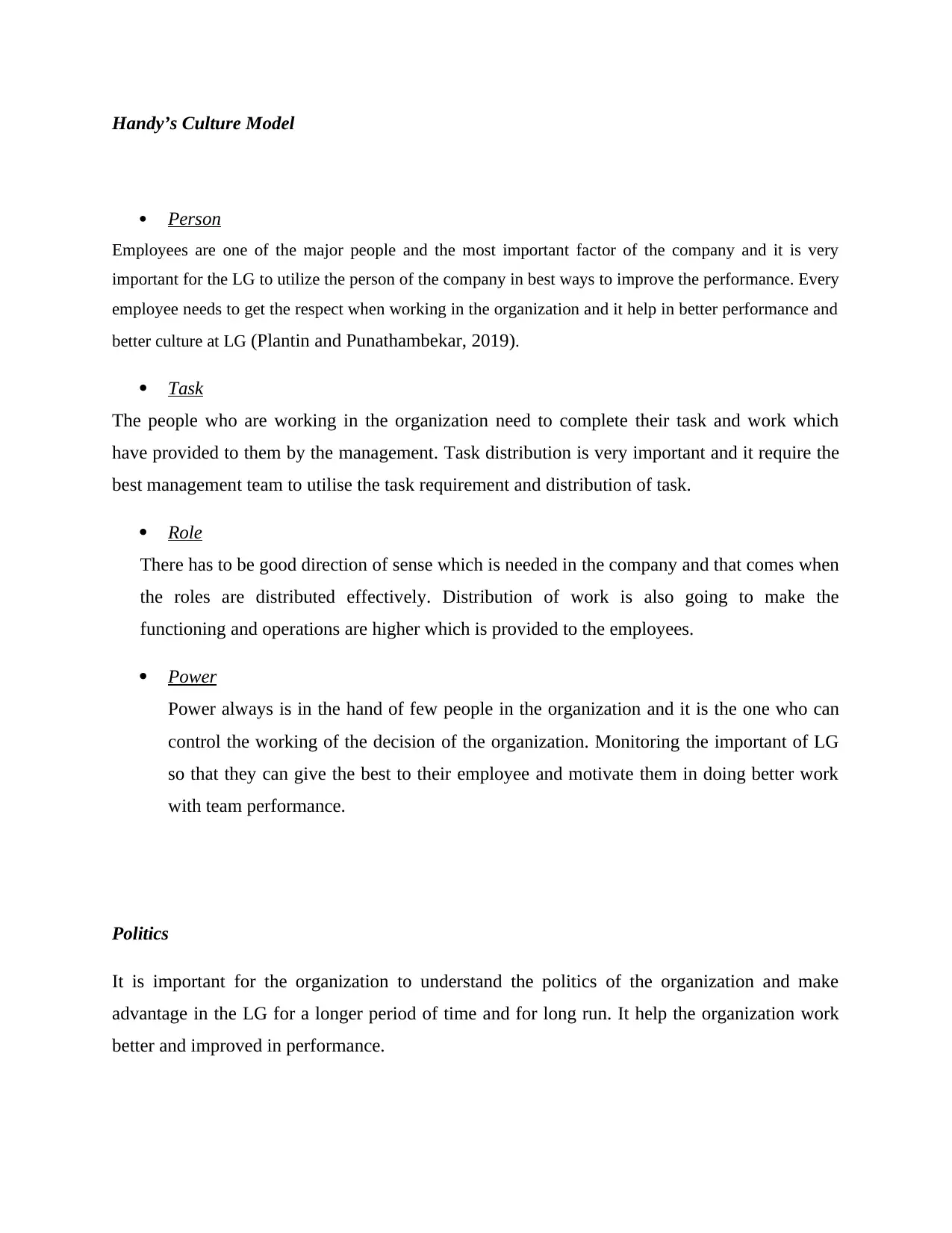
Handy’s Culture Model
Person
Employees are one of the major people and the most important factor of the company and it is very
important for the LG to utilize the person of the company in best ways to improve the performance. Every
employee needs to get the respect when working in the organization and it help in better performance and
better culture at LG (Plantin and Punathambekar, 2019).
Task
The people who are working in the organization need to complete their task and work which
have provided to them by the management. Task distribution is very important and it require the
best management team to utilise the task requirement and distribution of task.
Role
There has to be good direction of sense which is needed in the company and that comes when
the roles are distributed effectively. Distribution of work is also going to make the
functioning and operations are higher which is provided to the employees.
Power
Power always is in the hand of few people in the organization and it is the one who can
control the working of the decision of the organization. Monitoring the important of LG
so that they can give the best to their employee and motivate them in doing better work
with team performance.
Politics
It is important for the organization to understand the politics of the organization and make
advantage in the LG for a longer period of time and for long run. It help the organization work
better and improved in performance.
Person
Employees are one of the major people and the most important factor of the company and it is very
important for the LG to utilize the person of the company in best ways to improve the performance. Every
employee needs to get the respect when working in the organization and it help in better performance and
better culture at LG (Plantin and Punathambekar, 2019).
Task
The people who are working in the organization need to complete their task and work which
have provided to them by the management. Task distribution is very important and it require the
best management team to utilise the task requirement and distribution of task.
Role
There has to be good direction of sense which is needed in the company and that comes when
the roles are distributed effectively. Distribution of work is also going to make the
functioning and operations are higher which is provided to the employees.
Power
Power always is in the hand of few people in the organization and it is the one who can
control the working of the decision of the organization. Monitoring the important of LG
so that they can give the best to their employee and motivate them in doing better work
with team performance.
Politics
It is important for the organization to understand the politics of the organization and make
advantage in the LG for a longer period of time and for long run. It help the organization work
better and improved in performance.
Paraphrase This Document
Need a fresh take? Get an instant paraphrase of this document with our AI Paraphraser
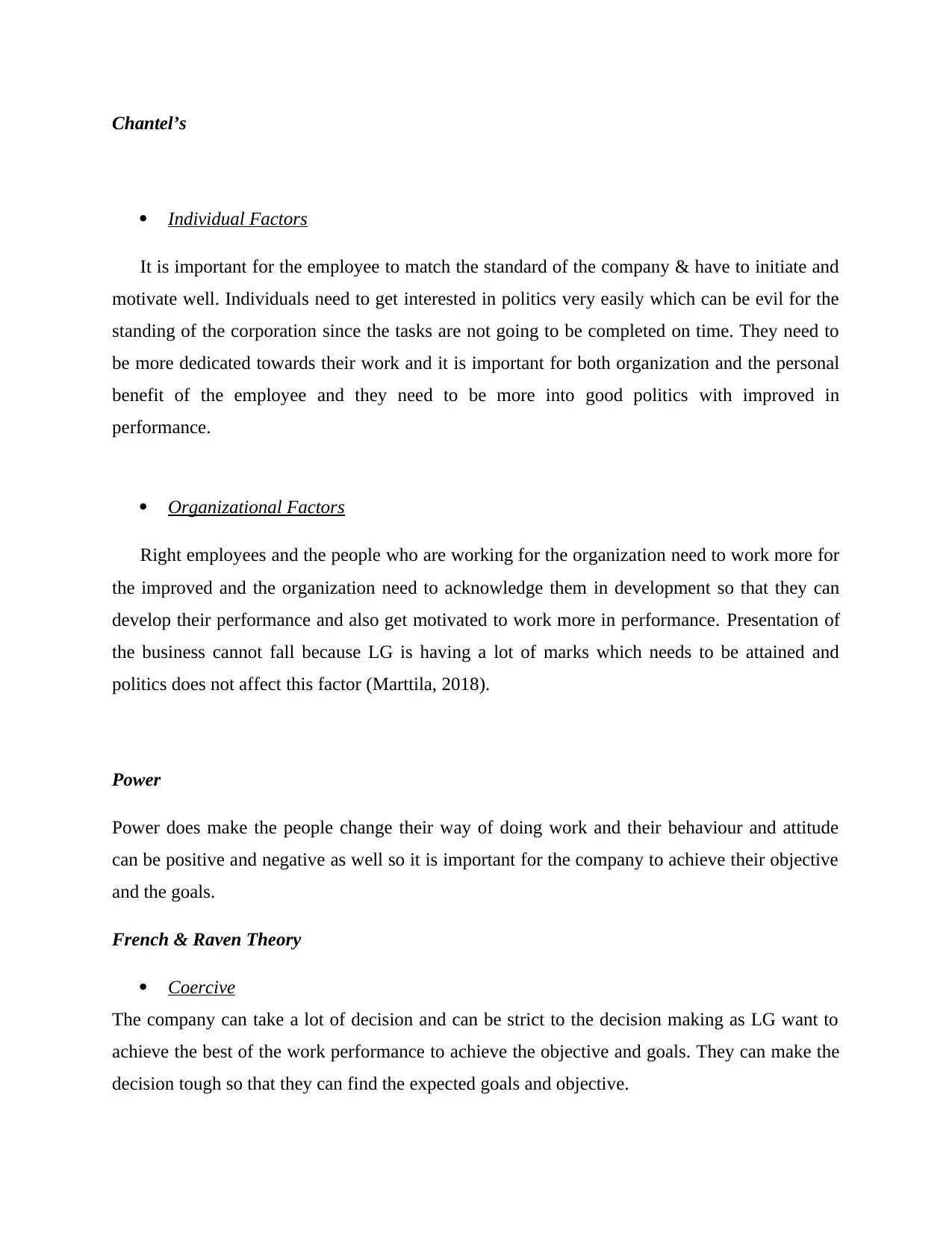
Chantel’s
Individual Factors
It is important for the employee to match the standard of the company & have to initiate and
motivate well. Individuals need to get interested in politics very easily which can be evil for the
standing of the corporation since the tasks are not going to be completed on time. They need to
be more dedicated towards their work and it is important for both organization and the personal
benefit of the employee and they need to be more into good politics with improved in
performance.
Organizational Factors
Right employees and the people who are working for the organization need to work more for
the improved and the organization need to acknowledge them in development so that they can
develop their performance and also get motivated to work more in performance. Presentation of
the business cannot fall because LG is having a lot of marks which needs to be attained and
politics does not affect this factor (Marttila, 2018).
Power
Power does make the people change their way of doing work and their behaviour and attitude
can be positive and negative as well so it is important for the company to achieve their objective
and the goals.
French & Raven Theory
Coercive
The company can take a lot of decision and can be strict to the decision making as LG want to
achieve the best of the work performance to achieve the objective and goals. They can make the
decision tough so that they can find the expected goals and objective.
Individual Factors
It is important for the employee to match the standard of the company & have to initiate and
motivate well. Individuals need to get interested in politics very easily which can be evil for the
standing of the corporation since the tasks are not going to be completed on time. They need to
be more dedicated towards their work and it is important for both organization and the personal
benefit of the employee and they need to be more into good politics with improved in
performance.
Organizational Factors
Right employees and the people who are working for the organization need to work more for
the improved and the organization need to acknowledge them in development so that they can
develop their performance and also get motivated to work more in performance. Presentation of
the business cannot fall because LG is having a lot of marks which needs to be attained and
politics does not affect this factor (Marttila, 2018).
Power
Power does make the people change their way of doing work and their behaviour and attitude
can be positive and negative as well so it is important for the company to achieve their objective
and the goals.
French & Raven Theory
Coercive
The company can take a lot of decision and can be strict to the decision making as LG want to
achieve the best of the work performance to achieve the objective and goals. They can make the
decision tough so that they can find the expected goals and objective.

Reward
Rewards are one of the best ways to motivate the performance of the organization as the manager need
to reward the employee so that they perform better and improved in their work. It is important for
them to make sure they develop the basic motivation through the rewards and acknowledgement.
Expert
There are a lot of people with experience in the organization in the LG and they can be beneficial
for the organization so that employee can get a good help from their experience and knowledge
which will help them in developed performance in LG.
Legitimate
The decision making power of the authority and the people working in the organization does not
like such power and for that the LG try and developed the process with taking the employee
reaction and consulting while taking the decision of the organization to understand the outcomes
better.
Referent
Due to charm, attitude looks, etc in rare persons there is an unfair and atmosphere of negativity
in the company which is going to make the motivation level fall and it can cause the LG in
negative image. Which is not good for the environment and the working performance of the
company (Liubashits and et.al., 2019).
P2: Role of motivation techniques in achieving organisational goals
Motivation is defined as the approach which guides, inspire, initiate and helps in
sustaining goal oriented attitude among individuals. For LG it is very important to encourage its
staff members to accomplish task. The lack of motivation factor can result in ineffective teams
and decreasing interest and moral of employees (Griffin and et.al., 2020). As a result along with
the poor employee retention companies may also face poor productivity and failure to achieve
tasks. For motivating staff members organisation can use various approaches. Motivation
techniques can be chosen on the basis of following theories:
Rewards are one of the best ways to motivate the performance of the organization as the manager need
to reward the employee so that they perform better and improved in their work. It is important for
them to make sure they develop the basic motivation through the rewards and acknowledgement.
Expert
There are a lot of people with experience in the organization in the LG and they can be beneficial
for the organization so that employee can get a good help from their experience and knowledge
which will help them in developed performance in LG.
Legitimate
The decision making power of the authority and the people working in the organization does not
like such power and for that the LG try and developed the process with taking the employee
reaction and consulting while taking the decision of the organization to understand the outcomes
better.
Referent
Due to charm, attitude looks, etc in rare persons there is an unfair and atmosphere of negativity
in the company which is going to make the motivation level fall and it can cause the LG in
negative image. Which is not good for the environment and the working performance of the
company (Liubashits and et.al., 2019).
P2: Role of motivation techniques in achieving organisational goals
Motivation is defined as the approach which guides, inspire, initiate and helps in
sustaining goal oriented attitude among individuals. For LG it is very important to encourage its
staff members to accomplish task. The lack of motivation factor can result in ineffective teams
and decreasing interest and moral of employees (Griffin and et.al., 2020). As a result along with
the poor employee retention companies may also face poor productivity and failure to achieve
tasks. For motivating staff members organisation can use various approaches. Motivation
techniques can be chosen on the basis of following theories:
⊘ This is a preview!⊘
Do you want full access?
Subscribe today to unlock all pages.

Trusted by 1+ million students worldwide
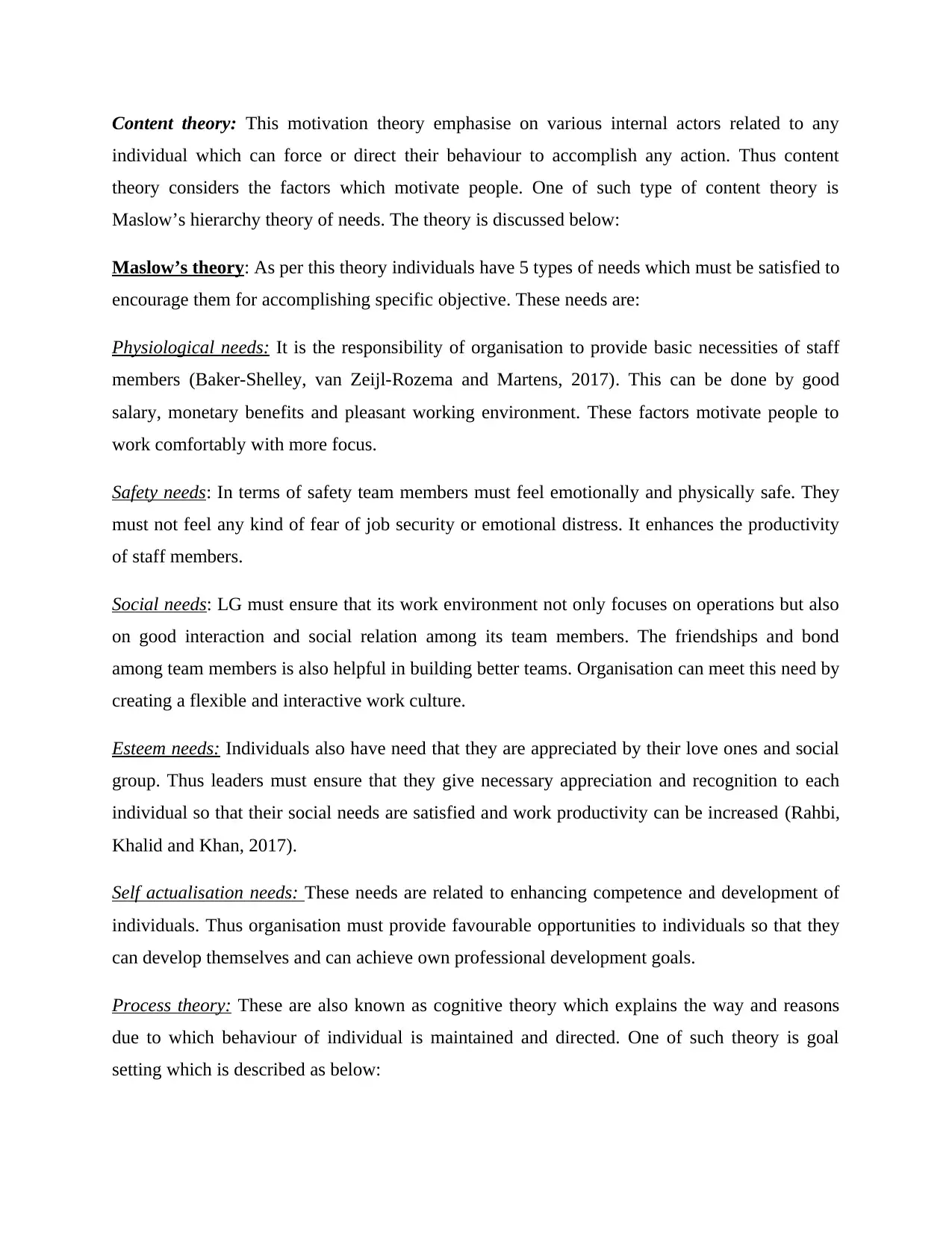
Content theory: This motivation theory emphasise on various internal actors related to any
individual which can force or direct their behaviour to accomplish any action. Thus content
theory considers the factors which motivate people. One of such type of content theory is
Maslow’s hierarchy theory of needs. The theory is discussed below:
Maslow’s theory: As per this theory individuals have 5 types of needs which must be satisfied to
encourage them for accomplishing specific objective. These needs are:
Physiological needs: It is the responsibility of organisation to provide basic necessities of staff
members (Baker-Shelley, van Zeijl-Rozema and Martens, 2017). This can be done by good
salary, monetary benefits and pleasant working environment. These factors motivate people to
work comfortably with more focus.
Safety needs: In terms of safety team members must feel emotionally and physically safe. They
must not feel any kind of fear of job security or emotional distress. It enhances the productivity
of staff members.
Social needs: LG must ensure that its work environment not only focuses on operations but also
on good interaction and social relation among its team members. The friendships and bond
among team members is also helpful in building better teams. Organisation can meet this need by
creating a flexible and interactive work culture.
Esteem needs: Individuals also have need that they are appreciated by their love ones and social
group. Thus leaders must ensure that they give necessary appreciation and recognition to each
individual so that their social needs are satisfied and work productivity can be increased (Rahbi,
Khalid and Khan, 2017).
Self actualisation needs: These needs are related to enhancing competence and development of
individuals. Thus organisation must provide favourable opportunities to individuals so that they
can develop themselves and can achieve own professional development goals.
Process theory: These are also known as cognitive theory which explains the way and reasons
due to which behaviour of individual is maintained and directed. One of such theory is goal
setting which is described as below:
individual which can force or direct their behaviour to accomplish any action. Thus content
theory considers the factors which motivate people. One of such type of content theory is
Maslow’s hierarchy theory of needs. The theory is discussed below:
Maslow’s theory: As per this theory individuals have 5 types of needs which must be satisfied to
encourage them for accomplishing specific objective. These needs are:
Physiological needs: It is the responsibility of organisation to provide basic necessities of staff
members (Baker-Shelley, van Zeijl-Rozema and Martens, 2017). This can be done by good
salary, monetary benefits and pleasant working environment. These factors motivate people to
work comfortably with more focus.
Safety needs: In terms of safety team members must feel emotionally and physically safe. They
must not feel any kind of fear of job security or emotional distress. It enhances the productivity
of staff members.
Social needs: LG must ensure that its work environment not only focuses on operations but also
on good interaction and social relation among its team members. The friendships and bond
among team members is also helpful in building better teams. Organisation can meet this need by
creating a flexible and interactive work culture.
Esteem needs: Individuals also have need that they are appreciated by their love ones and social
group. Thus leaders must ensure that they give necessary appreciation and recognition to each
individual so that their social needs are satisfied and work productivity can be increased (Rahbi,
Khalid and Khan, 2017).
Self actualisation needs: These needs are related to enhancing competence and development of
individuals. Thus organisation must provide favourable opportunities to individuals so that they
can develop themselves and can achieve own professional development goals.
Process theory: These are also known as cognitive theory which explains the way and reasons
due to which behaviour of individual is maintained and directed. One of such theory is goal
setting which is described as below:
Paraphrase This Document
Need a fresh take? Get an instant paraphrase of this document with our AI Paraphraser
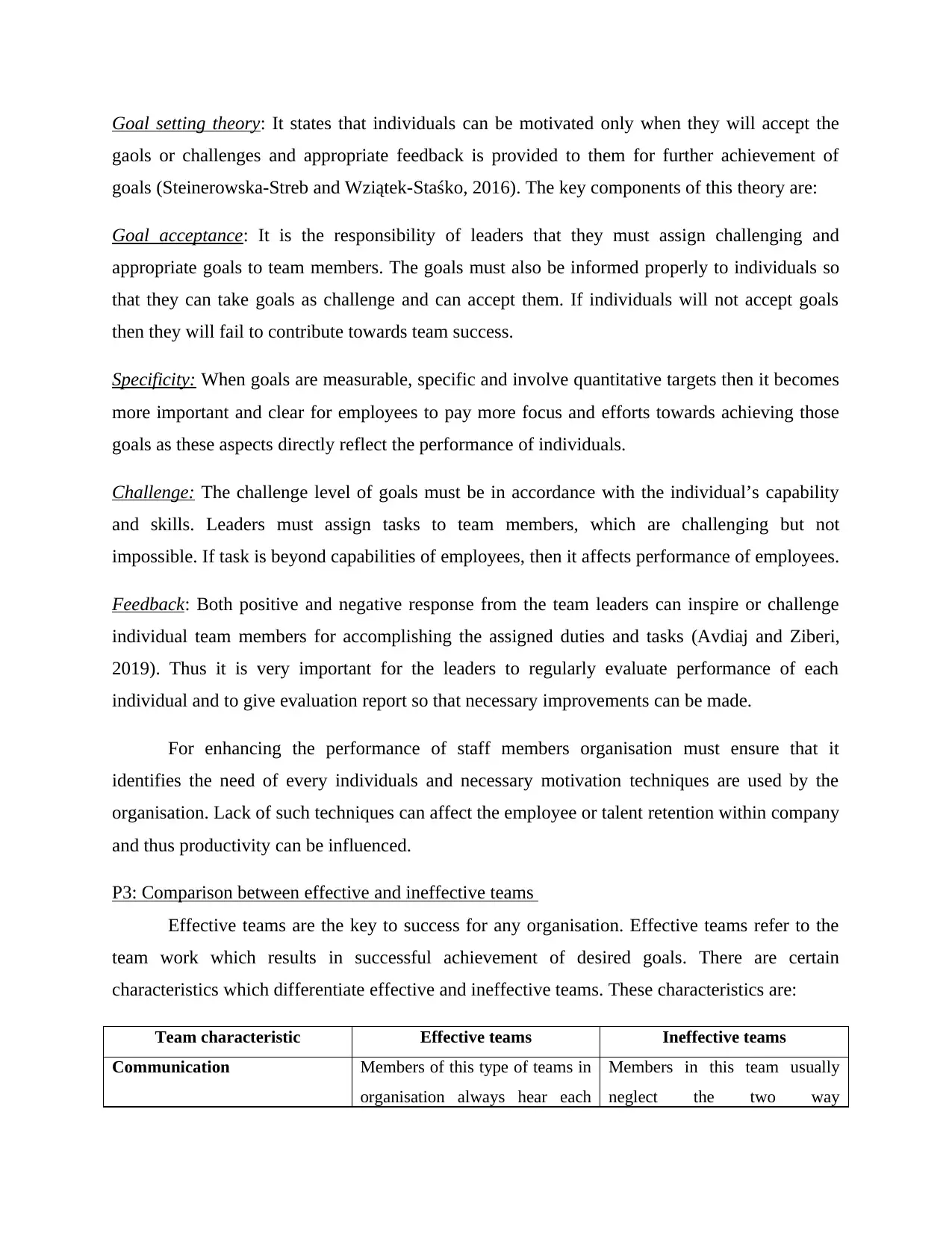
Goal setting theory: It states that individuals can be motivated only when they will accept the
gaols or challenges and appropriate feedback is provided to them for further achievement of
goals (Steinerowska-Streb and Wziątek-Staśko, 2016). The key components of this theory are:
Goal acceptance: It is the responsibility of leaders that they must assign challenging and
appropriate goals to team members. The goals must also be informed properly to individuals so
that they can take goals as challenge and can accept them. If individuals will not accept goals
then they will fail to contribute towards team success.
Specificity: When goals are measurable, specific and involve quantitative targets then it becomes
more important and clear for employees to pay more focus and efforts towards achieving those
goals as these aspects directly reflect the performance of individuals.
Challenge: The challenge level of goals must be in accordance with the individual’s capability
and skills. Leaders must assign tasks to team members, which are challenging but not
impossible. If task is beyond capabilities of employees, then it affects performance of employees.
Feedback: Both positive and negative response from the team leaders can inspire or challenge
individual team members for accomplishing the assigned duties and tasks (Avdiaj and Ziberi,
2019). Thus it is very important for the leaders to regularly evaluate performance of each
individual and to give evaluation report so that necessary improvements can be made.
For enhancing the performance of staff members organisation must ensure that it
identifies the need of every individuals and necessary motivation techniques are used by the
organisation. Lack of such techniques can affect the employee or talent retention within company
and thus productivity can be influenced.
P3: Comparison between effective and ineffective teams
Effective teams are the key to success for any organisation. Effective teams refer to the
team work which results in successful achievement of desired goals. There are certain
characteristics which differentiate effective and ineffective teams. These characteristics are:
Team characteristic Effective teams Ineffective teams
Communication Members of this type of teams in
organisation always hear each
Members in this team usually
neglect the two way
gaols or challenges and appropriate feedback is provided to them for further achievement of
goals (Steinerowska-Streb and Wziątek-Staśko, 2016). The key components of this theory are:
Goal acceptance: It is the responsibility of leaders that they must assign challenging and
appropriate goals to team members. The goals must also be informed properly to individuals so
that they can take goals as challenge and can accept them. If individuals will not accept goals
then they will fail to contribute towards team success.
Specificity: When goals are measurable, specific and involve quantitative targets then it becomes
more important and clear for employees to pay more focus and efforts towards achieving those
goals as these aspects directly reflect the performance of individuals.
Challenge: The challenge level of goals must be in accordance with the individual’s capability
and skills. Leaders must assign tasks to team members, which are challenging but not
impossible. If task is beyond capabilities of employees, then it affects performance of employees.
Feedback: Both positive and negative response from the team leaders can inspire or challenge
individual team members for accomplishing the assigned duties and tasks (Avdiaj and Ziberi,
2019). Thus it is very important for the leaders to regularly evaluate performance of each
individual and to give evaluation report so that necessary improvements can be made.
For enhancing the performance of staff members organisation must ensure that it
identifies the need of every individuals and necessary motivation techniques are used by the
organisation. Lack of such techniques can affect the employee or talent retention within company
and thus productivity can be influenced.
P3: Comparison between effective and ineffective teams
Effective teams are the key to success for any organisation. Effective teams refer to the
team work which results in successful achievement of desired goals. There are certain
characteristics which differentiate effective and ineffective teams. These characteristics are:
Team characteristic Effective teams Ineffective teams
Communication Members of this type of teams in
organisation always hear each
Members in this team usually
neglect the two way

other. They give respect to
opinion and idea of other
members as well.
communication and they even
neglect what other member or
leader is saying.
Underlying goals
Each team member has clarity
about team purpose and
individual role.
On the other hand team members
of ineffective teams do not
understand task objectives and
roles of each others.
Decision making Decisions in an effective team
are made by a consensus which
involves agreement and
appreciation of all members
(Sale, 2020) (Chumg and et.al.,
2016). Thus success as well as
failure of all decisions is
celebrated equally by all
members.
Contrary to this ineffective teams
take decision immaturely and
without any evaluation of
consequences or resolution of
conflicts.
Conflict resolution Effective team leaders manage
disagreement in better way and
thus conflicts are easily
suppressed by leaders. Even if
there are personal differences
among team members then they
are not reflected in goal
achievement of organisation.
These teams always reflect
disagreement and thus even
leaders are not able to resolve
personal differences among team
members.
Work division and leadership Effective team leaders always
involve all teams’ members in
making decision. The work is
also distributed uniformly and all
individuals help each other.
Ineffective teams involve leaders
who only impose their decisions
without acknowledging or
informing team members (Wood
and et.al., 2016). As a result of
this team members are not aware
of what other member is doing.
This often results in team failure
to achieve results.
opinion and idea of other
members as well.
communication and they even
neglect what other member or
leader is saying.
Underlying goals
Each team member has clarity
about team purpose and
individual role.
On the other hand team members
of ineffective teams do not
understand task objectives and
roles of each others.
Decision making Decisions in an effective team
are made by a consensus which
involves agreement and
appreciation of all members
(Sale, 2020) (Chumg and et.al.,
2016). Thus success as well as
failure of all decisions is
celebrated equally by all
members.
Contrary to this ineffective teams
take decision immaturely and
without any evaluation of
consequences or resolution of
conflicts.
Conflict resolution Effective team leaders manage
disagreement in better way and
thus conflicts are easily
suppressed by leaders. Even if
there are personal differences
among team members then they
are not reflected in goal
achievement of organisation.
These teams always reflect
disagreement and thus even
leaders are not able to resolve
personal differences among team
members.
Work division and leadership Effective team leaders always
involve all teams’ members in
making decision. The work is
also distributed uniformly and all
individuals help each other.
Ineffective teams involve leaders
who only impose their decisions
without acknowledging or
informing team members (Wood
and et.al., 2016). As a result of
this team members are not aware
of what other member is doing.
This often results in team failure
to achieve results.
⊘ This is a preview!⊘
Do you want full access?
Subscribe today to unlock all pages.

Trusted by 1+ million students worldwide
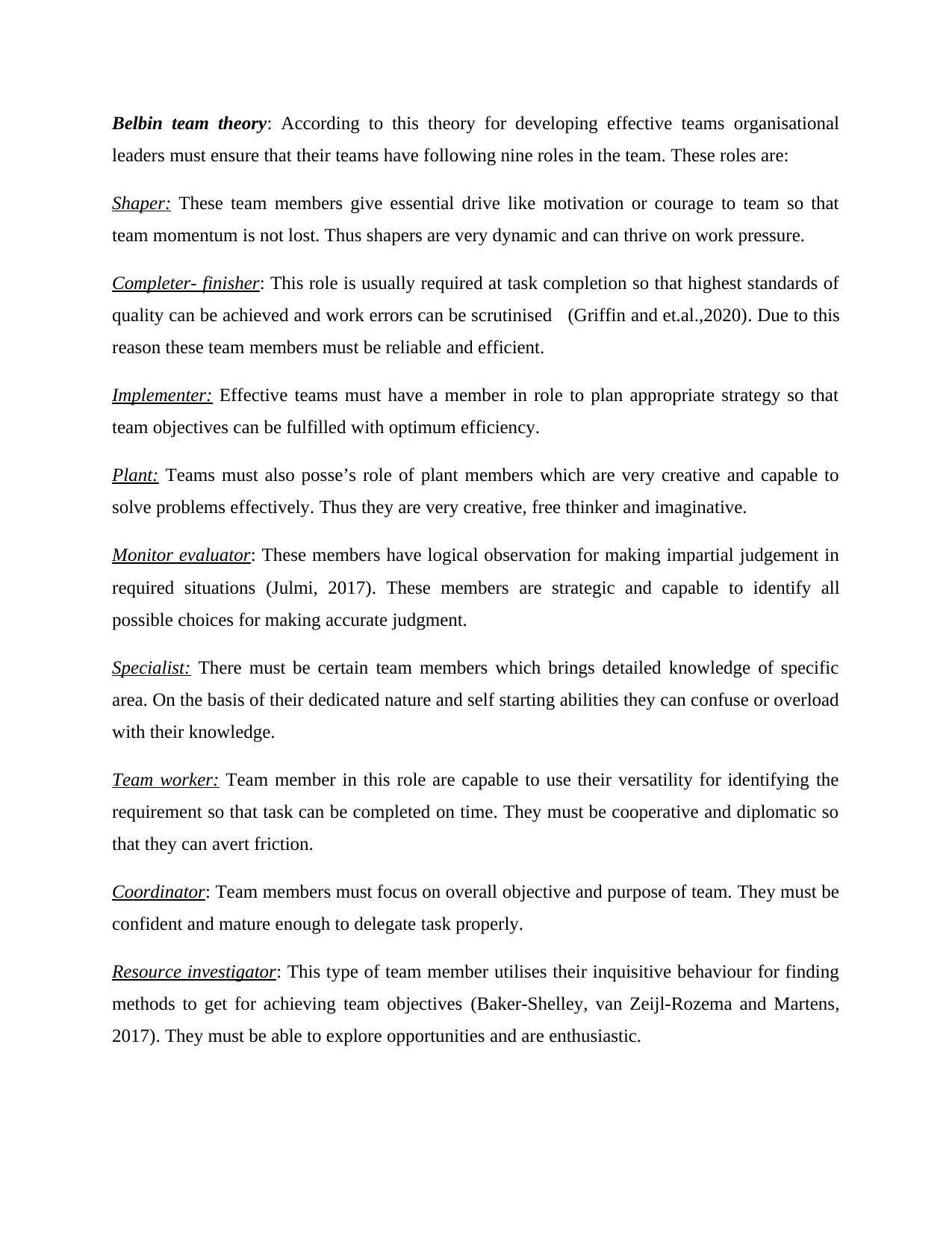
Belbin team theory: According to this theory for developing effective teams organisational
leaders must ensure that their teams have following nine roles in the team. These roles are:
Shaper: These team members give essential drive like motivation or courage to team so that
team momentum is not lost. Thus shapers are very dynamic and can thrive on work pressure.
Completer- finisher: This role is usually required at task completion so that highest standards of
quality can be achieved and work errors can be scrutinised (Griffin and et.al.,2020). Due to this
reason these team members must be reliable and efficient.
Implementer: Effective teams must have a member in role to plan appropriate strategy so that
team objectives can be fulfilled with optimum efficiency.
Plant: Teams must also posse’s role of plant members which are very creative and capable to
solve problems effectively. Thus they are very creative, free thinker and imaginative.
Monitor evaluator: These members have logical observation for making impartial judgement in
required situations (Julmi, 2017). These members are strategic and capable to identify all
possible choices for making accurate judgment.
Specialist: There must be certain team members which brings detailed knowledge of specific
area. On the basis of their dedicated nature and self starting abilities they can confuse or overload
with their knowledge.
Team worker: Team member in this role are capable to use their versatility for identifying the
requirement so that task can be completed on time. They must be cooperative and diplomatic so
that they can avert friction.
Coordinator: Team members must focus on overall objective and purpose of team. They must be
confident and mature enough to delegate task properly.
Resource investigator: This type of team member utilises their inquisitive behaviour for finding
methods to get for achieving team objectives (Baker-Shelley, van Zeijl-Rozema and Martens,
2017). They must be able to explore opportunities and are enthusiastic.
leaders must ensure that their teams have following nine roles in the team. These roles are:
Shaper: These team members give essential drive like motivation or courage to team so that
team momentum is not lost. Thus shapers are very dynamic and can thrive on work pressure.
Completer- finisher: This role is usually required at task completion so that highest standards of
quality can be achieved and work errors can be scrutinised (Griffin and et.al.,2020). Due to this
reason these team members must be reliable and efficient.
Implementer: Effective teams must have a member in role to plan appropriate strategy so that
team objectives can be fulfilled with optimum efficiency.
Plant: Teams must also posse’s role of plant members which are very creative and capable to
solve problems effectively. Thus they are very creative, free thinker and imaginative.
Monitor evaluator: These members have logical observation for making impartial judgement in
required situations (Julmi, 2017). These members are strategic and capable to identify all
possible choices for making accurate judgment.
Specialist: There must be certain team members which brings detailed knowledge of specific
area. On the basis of their dedicated nature and self starting abilities they can confuse or overload
with their knowledge.
Team worker: Team member in this role are capable to use their versatility for identifying the
requirement so that task can be completed on time. They must be cooperative and diplomatic so
that they can avert friction.
Coordinator: Team members must focus on overall objective and purpose of team. They must be
confident and mature enough to delegate task properly.
Resource investigator: This type of team member utilises their inquisitive behaviour for finding
methods to get for achieving team objectives (Baker-Shelley, van Zeijl-Rozema and Martens,
2017). They must be able to explore opportunities and are enthusiastic.
Paraphrase This Document
Need a fresh take? Get an instant paraphrase of this document with our AI Paraphraser
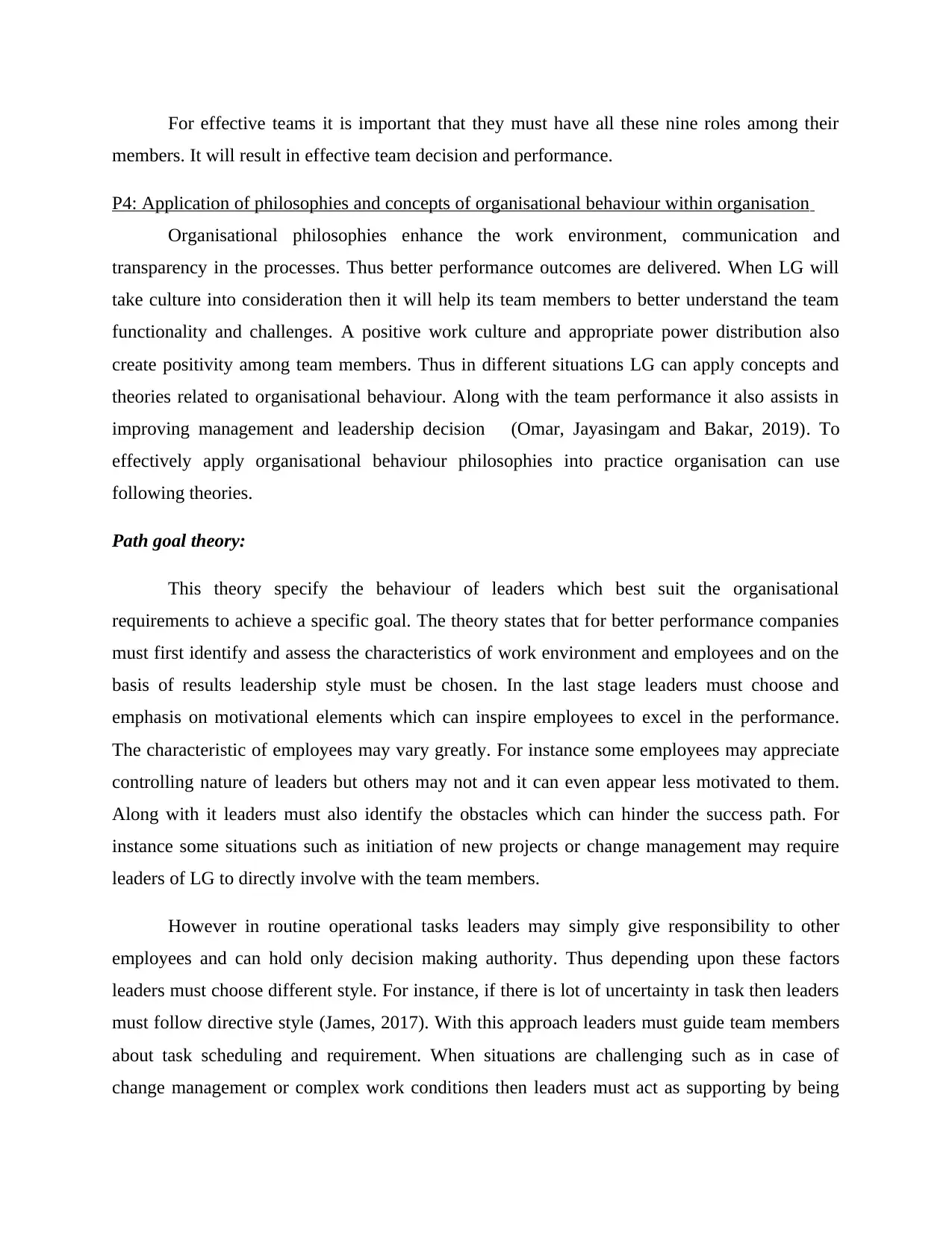
For effective teams it is important that they must have all these nine roles among their
members. It will result in effective team decision and performance.
P4: Application of philosophies and concepts of organisational behaviour within organisation
Organisational philosophies enhance the work environment, communication and
transparency in the processes. Thus better performance outcomes are delivered. When LG will
take culture into consideration then it will help its team members to better understand the team
functionality and challenges. A positive work culture and appropriate power distribution also
create positivity among team members. Thus in different situations LG can apply concepts and
theories related to organisational behaviour. Along with the team performance it also assists in
improving management and leadership decision (Omar, Jayasingam and Bakar, 2019). To
effectively apply organisational behaviour philosophies into practice organisation can use
following theories.
Path goal theory:
This theory specify the behaviour of leaders which best suit the organisational
requirements to achieve a specific goal. The theory states that for better performance companies
must first identify and assess the characteristics of work environment and employees and on the
basis of results leadership style must be chosen. In the last stage leaders must choose and
emphasis on motivational elements which can inspire employees to excel in the performance.
The characteristic of employees may vary greatly. For instance some employees may appreciate
controlling nature of leaders but others may not and it can even appear less motivated to them.
Along with it leaders must also identify the obstacles which can hinder the success path. For
instance some situations such as initiation of new projects or change management may require
leaders of LG to directly involve with the team members.
However in routine operational tasks leaders may simply give responsibility to other
employees and can hold only decision making authority. Thus depending upon these factors
leaders must choose different style. For instance, if there is lot of uncertainty in task then leaders
must follow directive style (James, 2017). With this approach leaders must guide team members
about task scheduling and requirement. When situations are challenging such as in case of
change management or complex work conditions then leaders must act as supporting by being
members. It will result in effective team decision and performance.
P4: Application of philosophies and concepts of organisational behaviour within organisation
Organisational philosophies enhance the work environment, communication and
transparency in the processes. Thus better performance outcomes are delivered. When LG will
take culture into consideration then it will help its team members to better understand the team
functionality and challenges. A positive work culture and appropriate power distribution also
create positivity among team members. Thus in different situations LG can apply concepts and
theories related to organisational behaviour. Along with the team performance it also assists in
improving management and leadership decision (Omar, Jayasingam and Bakar, 2019). To
effectively apply organisational behaviour philosophies into practice organisation can use
following theories.
Path goal theory:
This theory specify the behaviour of leaders which best suit the organisational
requirements to achieve a specific goal. The theory states that for better performance companies
must first identify and assess the characteristics of work environment and employees and on the
basis of results leadership style must be chosen. In the last stage leaders must choose and
emphasis on motivational elements which can inspire employees to excel in the performance.
The characteristic of employees may vary greatly. For instance some employees may appreciate
controlling nature of leaders but others may not and it can even appear less motivated to them.
Along with it leaders must also identify the obstacles which can hinder the success path. For
instance some situations such as initiation of new projects or change management may require
leaders of LG to directly involve with the team members.
However in routine operational tasks leaders may simply give responsibility to other
employees and can hold only decision making authority. Thus depending upon these factors
leaders must choose different style. For instance, if there is lot of uncertainty in task then leaders
must follow directive style (James, 2017). With this approach leaders must guide team members
about task scheduling and requirement. When situations are challenging such as in case of
change management or complex work conditions then leaders must act as supporting by being
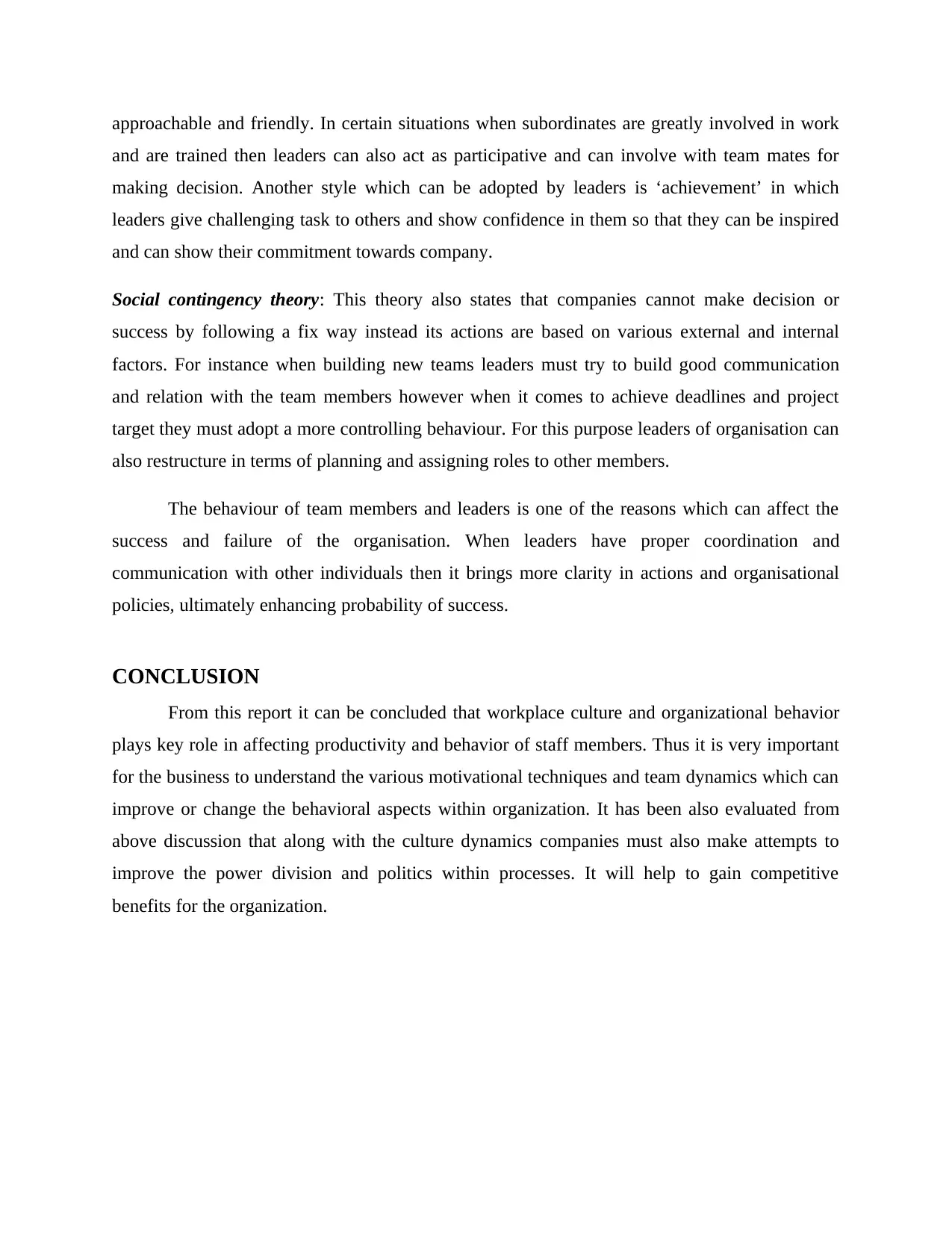
approachable and friendly. In certain situations when subordinates are greatly involved in work
and are trained then leaders can also act as participative and can involve with team mates for
making decision. Another style which can be adopted by leaders is ‘achievement’ in which
leaders give challenging task to others and show confidence in them so that they can be inspired
and can show their commitment towards company.
Social contingency theory: This theory also states that companies cannot make decision or
success by following a fix way instead its actions are based on various external and internal
factors. For instance when building new teams leaders must try to build good communication
and relation with the team members however when it comes to achieve deadlines and project
target they must adopt a more controlling behaviour. For this purpose leaders of organisation can
also restructure in terms of planning and assigning roles to other members.
The behaviour of team members and leaders is one of the reasons which can affect the
success and failure of the organisation. When leaders have proper coordination and
communication with other individuals then it brings more clarity in actions and organisational
policies, ultimately enhancing probability of success.
CONCLUSION
From this report it can be concluded that workplace culture and organizational behavior
plays key role in affecting productivity and behavior of staff members. Thus it is very important
for the business to understand the various motivational techniques and team dynamics which can
improve or change the behavioral aspects within organization. It has been also evaluated from
above discussion that along with the culture dynamics companies must also make attempts to
improve the power division and politics within processes. It will help to gain competitive
benefits for the organization.
and are trained then leaders can also act as participative and can involve with team mates for
making decision. Another style which can be adopted by leaders is ‘achievement’ in which
leaders give challenging task to others and show confidence in them so that they can be inspired
and can show their commitment towards company.
Social contingency theory: This theory also states that companies cannot make decision or
success by following a fix way instead its actions are based on various external and internal
factors. For instance when building new teams leaders must try to build good communication
and relation with the team members however when it comes to achieve deadlines and project
target they must adopt a more controlling behaviour. For this purpose leaders of organisation can
also restructure in terms of planning and assigning roles to other members.
The behaviour of team members and leaders is one of the reasons which can affect the
success and failure of the organisation. When leaders have proper coordination and
communication with other individuals then it brings more clarity in actions and organisational
policies, ultimately enhancing probability of success.
CONCLUSION
From this report it can be concluded that workplace culture and organizational behavior
plays key role in affecting productivity and behavior of staff members. Thus it is very important
for the business to understand the various motivational techniques and team dynamics which can
improve or change the behavioral aspects within organization. It has been also evaluated from
above discussion that along with the culture dynamics companies must also make attempts to
improve the power division and politics within processes. It will help to gain competitive
benefits for the organization.
⊘ This is a preview!⊘
Do you want full access?
Subscribe today to unlock all pages.

Trusted by 1+ million students worldwide
1 out of 14
Related Documents
Your All-in-One AI-Powered Toolkit for Academic Success.
+13062052269
info@desklib.com
Available 24*7 on WhatsApp / Email
![[object Object]](/_next/static/media/star-bottom.7253800d.svg)
Unlock your academic potential
Copyright © 2020–2025 A2Z Services. All Rights Reserved. Developed and managed by ZUCOL.




